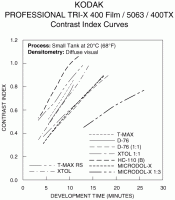I am paying more attention to development compensation for scenes greater and lesser than 6 stops.
Do you use a per-cent value of development time for each stop to be compensated for; if so, what do you consider an accurate per-cent for one and two stops?
I realize there is probably not a fixed value across the board for "all films in all developers all the time", but perhaps there is a generalization that can be applied.
Thank you,
Do you use a per-cent value of development time for each stop to be compensated for; if so, what do you consider an accurate per-cent for one and two stops?
I realize there is probably not a fixed value across the board for "all films in all developers all the time", but perhaps there is a generalization that can be applied.
Thank you,












